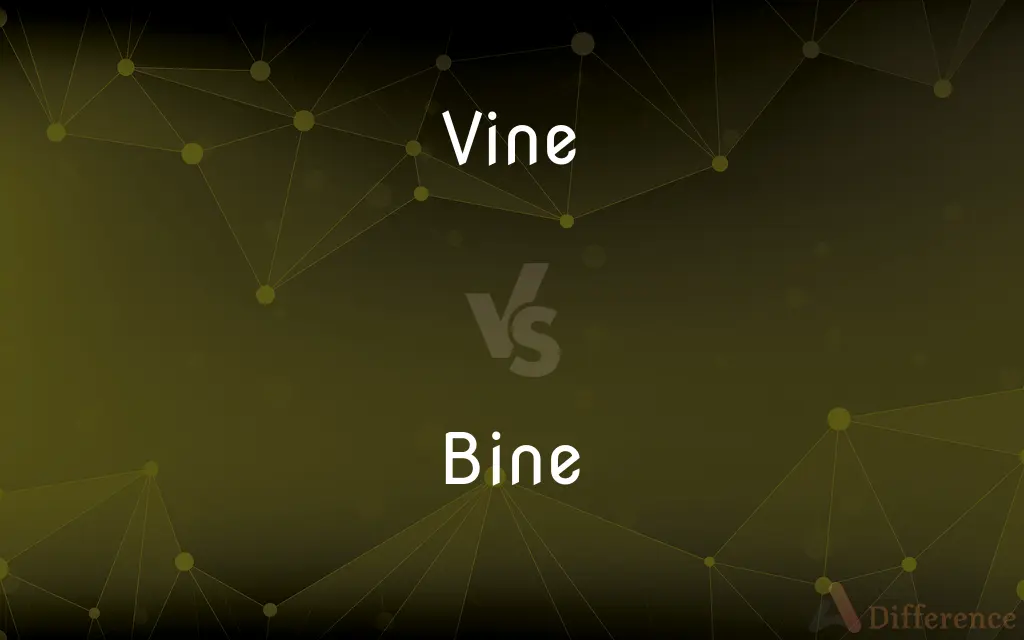Vine vs. Bine — What's the Difference?
Edited by Tayyaba Rehman — By Maham Liaqat — Updated on April 8, 2024
A vine climbs using tendrils or suckers to adhere to surfaces, while a bine wraps around objects with its stems for support.

Difference Between Vine and Bine
Table of Contents
ADVERTISEMENT
Key Differences
Vines are plants that use various mechanisms, such as tendrils, suckers, or other gripping appendages, to climb and support themselves against structures or other plants. These mechanisms allow vines to reach sunlight and spread over a large area without investing much energy in developing sturdy support structures. On the other hand, bines are a type of climbing plant that uses its entire stem to coil around a support structure for upward growth. This spiraling growth pattern enables bines to secure themselves as they ascend towards the light, relying on the physical strength of their stems rather than external appendages.
The growth habit of vines often requires external structures, like trees, fences, or walls, for support. This dependency means that vines can cover surfaces quickly, creating dense foliage. Whereas, bines, with their helical growth, can be more selective in their supports, often preferring slender poles or other plants that can accommodate their twining stems. This difference in support mechanism leads to varying impacts on the environments where these plants grow.
In terms of maintenance, vines may need more careful management to prevent them from damaging structures with their tendrils or suckers, which can become invasive. Bines, while also potentially vigorous growers, generally pose less risk to the surfaces they climb, as their method of ascent is less likely to cause damage. This distinction is crucial for gardeners and landscape designers when choosing plants for specific locations.
The reproductive strategies of vines and bines also differ, although this is more closely related to the species of plant than the climbing method itself. Vines can spread through a variety of mechanisms, including rooting at nodes or spreading seeds, while bines may rely more on seed spread due to their less aggressive ground coverage. This aspect influences how each plant type contributes to its ecosystem, from providing habitats to affecting biodiversity.
The terminology and classification of plants as vines or bines reflect their evolutionary adaptations to climbing. Vines have developed various specialized structures to aid in their climb, showing a wide range of evolutionary solutions to the problem of reaching sunlight. Bines, with their straightforward method of coiling stems, represent a different approach to the same challenge, highlighting the diversity of strategies in the plant kingdom.
ADVERTISEMENT
Comparison Chart
Climbing Mechanism
Tendrils, suckers, or other appendages
Coiling stems
Support Needs
Requires structures or plants for support
Prefers slender supports for coiling
Growth Impact
Can cover surfaces quickly, potentially invasive
Less likely to damage supports, selective in climbing
Maintenance
May damage structures, requires management
Generally poses less risk, easier to manage
Reproductive Strategy
Varied, including rooting at nodes or seed spread
Primarily through seed spread
Compare with Definitions
Vine
Requires careful placement and support.
He chose a sturdy trellis to support the heavy vine.
Bine
Its growth pattern is helical or spiraling.
The bine's stems formed a beautiful spiral pattern as they grew around the trellis.
Vine
A plant that climbs using tendrils or suckers.
The vine used its tendrils to climb the trellis and spread across the fence.
Bine
Uses its own stem for climbing, without tendrils.
With no tendrils to anchor it, the bine relied on its stem's strength to climb.
Vine
Can become invasive if not managed.
The fast-growing vine soon covered the entire wall of the house.
Bine
Generally easier to manage and less invasive.
The bine grew quickly but remained contained to its designated area.
Vine
Uses external structures for support.
The gardener trained the vine along the fence for optimal sunlight exposure.
Bine
Climbs by wrapping its stem around supports.
The bine twisted around the pole, reaching upwards towards the sun.
Vine
Provides dense foliage and coverage.
The vine created a lush, green privacy screen between the two yards.
Bine
Prefers slender, vertical supports.
The gardener provided thin bamboo sticks for the bine to climb.
Vine
A vine (Latin vīnea "grapevine", "vineyard", from vīnum "wine") is any plant with a growth habit of trailing or scandent (that is, climbing) stems, lianas or runners. The word vine can also refer to such stems or runners themselves, for instance, when used in wicker work.In parts of the world, including the British Isles, the term "vine" usually applies exclusively to grapevines (Vitis), while the term "climber" is used for all climbing plants.
Bine
The flexible twining or climbing stem of certain plants, such as the hop, woodbine, or bindweed.
Vine
A weak-stemmed plant that derives its support from climbing, twining, or creeping along a surface.
Bine
(botany) A climbing plant which climbs by its shoots growing in a helix around a support (distinct from a vine, which climbs using tendrils or suckers).
Vine
The stem of such a plant.
Bine
Cigarette
Vine
A grapevine.
Bine
The winding or twining stem of a hop vine or other climbing plant.
Vine
Grapevines considered as a group
Products of the vine.
Bine
European twining plant whose flowers are used chiefly to flavor malt liquors; cultivated in America
Vine
To form or develop like a vine.
Vine
The climbing plant that produces grapes.
They picked the grapes off the vine.
Vine
Any plant of the genus Vitis.
Vine
(by extension) Any similar climbing or trailing plant.
Vine
Any woody climbing plant which bears grapes.
There shall be no grapes on the vine.
And one went out into the field to gather herbs, and found a wild vine, and gathered thereof wild gourds.
Vine
Weak-stemmed plant that derives support from climbing, twining, or creeping along a surface
Common Curiosities
Are bines less invasive than vines?
Generally, yes, because bines do not use tendrils or suckers that can adhere aggressively to surfaces.
Can both vines and bines be used for decorative purposes?
Yes, both can be aesthetically pleasing and are used in gardens and landscapes.
What makes a plant a vine or a bine?
A vine uses tendrils or suckers to climb, while a bine uses its coiling stems.
Can vines damage structures?
Yes, vines can damage structures if not properly managed due to their climbing mechanisms.
How do vines and bines differ in their climbing methods?
Vines climb using external appendages, whereas bines spiral around supports with their stems.
Do both vines and bines need supports to grow?
Yes, both types need some form of support, but their mechanisms for climbing and types of supports preferred differ.
Is it easier to manage a bine compared to a vine?
Often, yes, because bines are less likely to cause structural damage and are less invasive.
Which is better for wildlife, vines or bines?
Both can provide habitats and resources for wildlife, though the impact depends on the specific plant species and environment.
Do vines or bines grow faster?
This can vary widely depending on the species, but vines are often perceived to grow faster due to their ability to quickly cover surfaces.
Are there any perennial bines?
Yes, there are perennial bines that return year after year, just as there are perennial vines.
Why would a gardener choose a vine over a bine, or vice versa?
The choice depends on the desired aesthetic, the available support structures, and the gardener's willingness to manage invasive growth.
Can bines grow without any support?
While they might grow without support, bines typically need something to coil around for optimal growth and health.
What kind of maintenance do vines require?
Vines may require pruning, training, and monitoring to prevent damage to structures and control invasive growth.
How do bines contribute to their ecosystem?
Bines can provide vertical greenery, support biodiversity, and offer habitats for various species.
Can vines and bines be harmful to trees?
Yes, if not managed properly, both can overwhelm and damage trees by blocking sunlight or strangling limbs and trunks.
Share Your Discovery

Previous Comparison
Energy vs. Strength
Next Comparison
Sightseeing vs. TourismAuthor Spotlight
Written by
Maham LiaqatEdited by
Tayyaba RehmanTayyaba Rehman is a distinguished writer, currently serving as a primary contributor to askdifference.com. As a researcher in semantics and etymology, Tayyaba's passion for the complexity of languages and their distinctions has found a perfect home on the platform. Tayyaba delves into the intricacies of language, distinguishing between commonly confused words and phrases, thereby providing clarity for readers worldwide.
















































